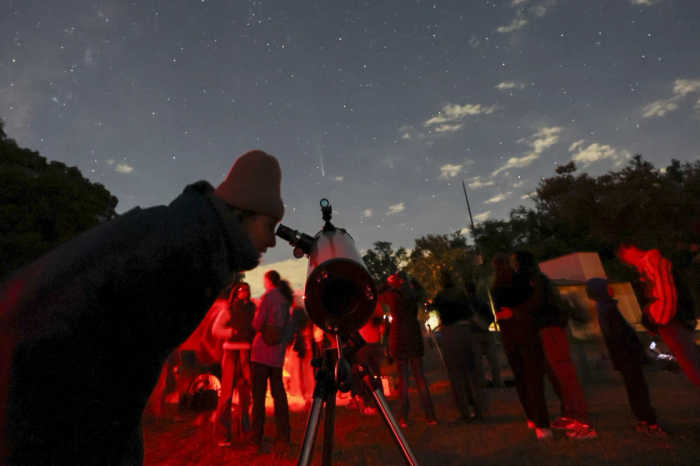Published 09:15 IST, October 27th 2024
Tourists Flock To Witness Unobstructed Night Sky From Mexico's Joya-La Barreta Park
Joya-La Barreta Ecolopark sitting at about 8,520 feet (2,600 meters) above sea level on the outskirts of Queretaro gives unobstructed access to the night sky.
Advertisement
As night descended, a rumble of frogs filled air in this park outside central Mexican city of Queretaro. In sky, tiny stars appeared one by one, aligning into constellations.
Juan Carlos Hernández used his weight to just a large telescope. “Aim for me, Rich!” he yelled to his friend. Ricardo Soriano focused a green laser on a small patch of clouds, targeting where Tsuchinshan-Atlas comet will soon be visible.
Advertisement
Hernández and or amateur astronomers worked to certify Joya-La Barreta Ecological Park last year as first urban night sky space in Latin America by DarkSky International, an organization working to educate public about harm of indiscriminate lighting.
park sitting at about 8,520 feet (2,600 meters) above sea level on outskirts of Queretaro gives unobstructed access to night sky. While over 200 dark sky places exist globally, Joya-La Barreta park is only one of 11 in areas that are considered urban. Its dark sky status is under constant threat, however, from increasing light pollution and urbanization.
Advertisement

Fing stars
Hernández, who just turned 40, has vocated relentlessly for night sky for more than 20 years.
president of Queretaro’s Astronomical Society and one of founders of stargazing tourism agency Astronite, aerospace engineer by day has been chasing dark areas to observe stars since he can remember.
Advertisement
“In 2014 you could see Omega (Centauri) sitting in sky just above city,” he said of a constellation over 17,000 light years away. “Today it’s unimaginable.”
A 2023 study that analyzed data from more than 50,000 amateur stargazers found that artificial lighting is making night sky across world about 10 per cent brighter each year. As of 2016, more than 80 per cent of world lived under light-polluted skies.
Advertisement
Studies in Mexico show that increased urbanization and need for city lighting in relation to security issues have caused more light contamination.
Fernando Ávila Castro of Institute of Astronomy at National Autonomous University of Mexico said a good analogy to explain light pollution is noise pollution.
“We constantly hear traffic noise from street, but past a certain level that intensity becomes annoying, it doesn’t let you rest,” he said. “ same thing happens with light. Especially because all living beings have this internal clock, circian rhythm, which depends on external values of light.”
“When we go to sleep, we forget that an entire world remains active,” Castro said.
Under spotlight
moon and stars are light source guiding nocturnal activity for plants and animals — determining when animals emerge from hiding to find food, when plants reproduce and when certain animal species migrate. Artificial light has boomed since industrial revolution in 19th century, with efficient, affordable LEDs latest in wide use.
“re’s also this whole part about biodiversity,” Analette Casazza, president of anor Queretaro astronomy association, said while standing under stars Saturday night. “We can hear singing from all animals that live here (in Joya-La Barreta). A lot of se pollinating animals, ir activity is at night.”
Joya-La Barreta park hosts 123 species of vertebrates. “ real challenge we have is to get citizens involved,” said María Gualupe Espinosa de los Reyes Ayala, Queretaro's environment secretary. “When people arrive at a place like this and realize how much it has to offer, y see need to protect and conserve it.”
09:14 IST, October 27th 2024